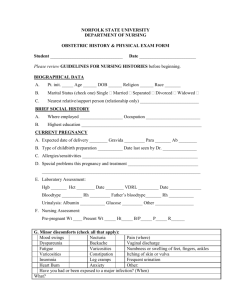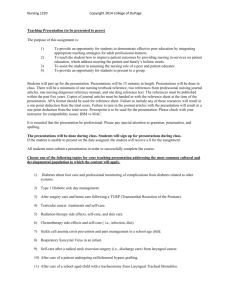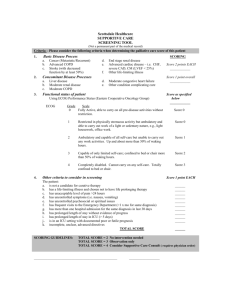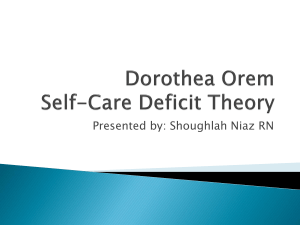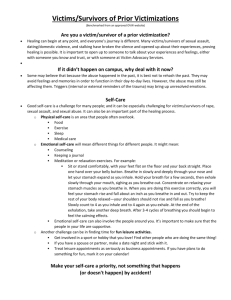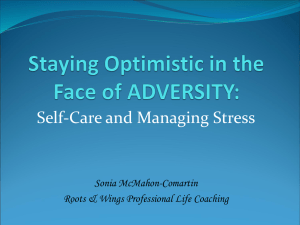Self-care Requisites
advertisement
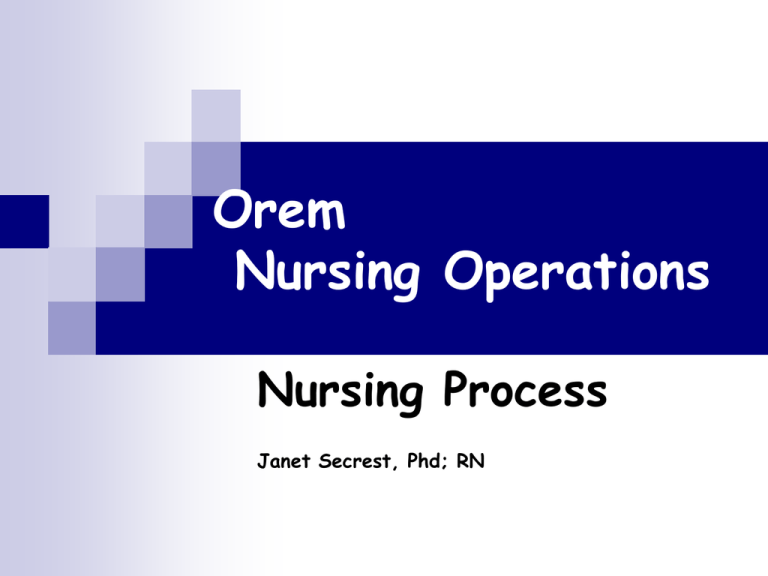
Orem Nursing Operations Nursing Process Janet Secrest, Phd; RN Handouts 1. Nursing Operations: Nursing Process/Nursing Care Plan 2. Nursing Care Planning Guide 3. Nursing Diagnoses by Self-care Requisite Objectives 1. Relate Nursing Process to Standards of Practice 2. Explain each concept 3. Link each concept 4. Develop tentative self-care deficit statement 5. Develop tentative design and plan Level Objectives Formulate a plan of care to promote self-care agency Curriculum Outcomes Systematically evaluate the quality of nursing practice Evaluate own nursing practice in relation to professional practice standards and relevant statutes and regulations ANA Scope & Standards of Practice 15 First 6—assessment, diagnosis, outcomes identification, planning, implementation, evaluation 9. Evaluate own nursing practice in relation to professional practice standards and relevant statutes and regulations How do we know if nursing is needed? PURPOSE Is there a need for nursing? **theory of self care What does nursing do? What does nursing uniquely add to patient care? Self (dependent)care Agency Self -care Carpenito attributes this more to PT– We respectfully, but STRENUOUSLY disagree Assess Evaluate Diagnose Implement Plan Control Diagnosis (Evaluate) (Assess, diagnose) Regulate Prescription (Implement) (goal/outcomes) may also see “diagnosis and prescription” Design (Plan) Health History BCF PC USCR DSCR HDSCR basic conditioning factors 1. Age, 2. Gender 3. Health State 4. Developmental State 5. Family System 6. Sociocultural Spiritual basic conditioning factors 7. Healthcare System Factors 8. Patterns of Living 9. Environmental Factors 10.Resources Health state Pneumonia Is there a therapeutic demand on USCR: Air Yes, patient cannot sleep at night lying down. When he walks to the bathroom without O2, his sat drops to **% Health state Pneumonia Does the patient have the ability to meet this therapeutic demand on USCR: Air Patient has hospital bed at home that he can raise the head of; his wife is very knowledgeable about his condition and has gotten extension tubing so his O2 will reach the bathroom. The home health nurse will visit the day of discharge to assess home needs. Health state Pneumonia Does the patient have the ability to meet this therapeutic demand on USCR: Air The patient’s dependent care agent will be meeting therapeutic demand for air. YES universal self-care requisites 1. Air 2. Food 3. Water 4. Elimination universal self-care requisites 5. Balance: activity and rest 6. Balance: solitude and social interaction 7. Px hazards to life, functioning, well being 8. Promotion of normalcy Air Food Water Elimination rest./activity Solitude/social interaction Px hazards, Promote WB Normalcy Power Components Body Control Vigilance Energy Repertoire of skills Technical knowledge Performing integrating skills Motivation Reasoning Decision making ABILITIES Prioritize Orem’s Developmental Stages Intrauterine Adulthood Neonatal Infancy Pregnancy Childhood Adolescence Orem, 2001, pp. 225-227 developmental self-care requisites 1. Provision of conditions that promote development 2. Engagement in self-development developmental self-care requisites 3. Provide conditions that prevent / overcome existent deleterious effects on development developmental self-care requisites (1of3) 1. Educational deprivation 2. Problems of social adaptation 3. Failures of healthy individuation developmental self-care requisites (2of3) 4. Loss of relatives, friends, associates 5. Loss of possessions, loss of occupational security 6. Abrupt change of residence to an unfamiliar environment 7. Status-associated problems developmental self-care requisites (3of3) 8. Poor health or disability 9. Oppressive living conditions 10. Terminal illness and impending death health deviation self-care requisites 1. Seeking/securing appropriate medical assistance 2. Being aware of/attending to effects of pathological conditions 3. Effectively carrying out medical regimen health deviation self-care requisites 4. Attending to side effects of medical regimen 5. Modifying self concept 6. Learning to live with effects of pathologic condition Examine, analyze data; make judgments about Relationship of BCF/PC and USCR DSCR HDSCR and means for meeting therapeutic demands Power Components universal health deviation Self Care Requisites Assess, examine, analyze, judge BCF Developmental When a deficit occurs Consult Nsg Dx list by USCR Form tentative Self-care deficit statement also known as Nursing Diagnosis UNIVERSAL SELF CARE REQUISITES AIR SOLITUDE-SOCIAL INTERACTION Airway clearance, ineffective Aspiration, risk for Breathing pattern, ineffective Gas exchange, impaired Spontaneous ventilation: inability to sustain Ventilatory weaning response, dysfunctional Ventilation, impaired spontaneous Relocation stress syndrome Relocation stress syndrome, risk for Self-concept, readiness for enhanced Self-esteem, chronic low Self-esteem, situational low Self-esteem, situational low, risk for Sorrow, chronic Spiritual distress Spiritual distress, risk for Caregiver role strain Caregiver role strain, risk for Communication impaired, verbal Communication, readiness for enhanced Community coping, enhanced, potential for Community coping, ineffective Environmental interpretation syndrome, impaired Failure to thrive, adult Family coping, ineffective: compromised Family coping, ineffective: disabling Family coping, potential for growth Family process, dysfunctional: alcoholism Family processes, interrupted Family processes, readiness for enhanced Loneliness, risk for Parent/infant/child attachment impaired, risk for Parental role conflict Parenting, impaired Parenting, impaired, risk for WATER Cardiac output, decreased Dysreflexia Tissue perfusion, ineffective (specify: cerebral, cardio-pulmonary, renal, gastrointestinal peripheral) Fluid volume deficit Fluid volume deficit, risk for Fluid volume excess Fluid volume imbalance, risk for Fluid volume, readiness for enhanced Oral mucous membranes, impaired Swallowing, impaired FOOD Breastfeeding, effective Breastfeeding, ineffective Breastfeeding, interrupted Dentition, impaired Infant feeding pattern, ineffective Ineffective airway clearance (p. 537) Self Care Deficit Statement (Nursing Diagnosis) Definition Defining characteristics Major? Minor? ? Focus assessment needed Self-Care Deficit Statement (diagnosis) Includes diagnostic label and etiology Label & etiology linked by relationship (“related to”) Direct causation NOT attributed (NO “due to”) Ineffective airway clearance related to ineffective cough secondary to paralysis of quadriplegia Diagnostic Label Definition must “fit” patient’s selfcare deficit Defining characteristics must be in health history Etiology Nurse must be able to assess (i.e., no medical diagnosis) Evidence must be in health history Etiology May be more than 1 etiology; all etiologies should be included Use etiologies in Carpenito (hint: at this level it would be unusual that you would not find one to fit your patient in this book) Ineffective airway clearance related to ineffective cough secondary to quadriplegia and r/t excessive secretions secondary to pneumonia Power Components health deviation universal Self Care Requisites Assess, examine, analyze, judge BCF Developmental Self care deficit statement “diagnostic label related to etiology” Prescription and Design Particularized Self-Care Requisite Statement (Goal) 1. From patient’s perspective (the patient will . . . 2. Relate to the diagnostic label Prescription and Design Particularized Self-Care Requisite Statement (Goal) 3. Measurable (see list of verbs), within time frame 4. Realistic the patient will not experience aspiration (Carpenito, p. 628) The patient will report clear airway q. shift; will verbalize measures to maintain clear airway Planning for regulatory operations Nursing System Utilized Wholly Compensatory Partially Compensatory Supportive-Educative Power Components health deviation universal Self Care Requisites Assess, examine, analyze, judge BCF Developmental Self care deficit statement “diagnostic label related to etiology” Particularized self care requisite statement “by Feb. 1 the patient will . . . “ Regulation 1. Assess O2 sat Nursing system ?wholly ?partially ?supportive-educative Nursing interventions Written as nursing orders Directed toward the etiology individualized Short clear commands direct who, what, when where, how Nursing interventions Caveat Carpenito has a menu of interventions to choose from—your task is to make the intervention individualized for your patient Methods of Helping Acting/doing Guiding Supporting Teaching Providing developmental environment Interventions: 4 categories 1. Evaluative 2. Attending to the Etiology eliminating / reducing/ mitigating /adapting to 3. Teaching 4. Referring Interventions 1. evaluative 1. Assess breath sounds and pt’s subjective feeling of airway clearance q 4 h Interventions 2. “attend” to etiology 2. Instruct pt to call for assistive cough q 1hour while awake 3. Maintain hourly assistive check list at bedside Interventions 2. “attend” to etiology 4. Instruct pt to call for assistive cough every hour while awake 5. Suction secretions pt is able to bring to posterior oral pharynx with assistive cough Interventions 3. teach 4. refer 6. Teach wife assistive cough technique 7. Complete home health referral on 9/30 Evidence For each intervention, state detailed rationale with the strongest scientific evidence Pathophysiology text CINAHL search for recent study/literature discussions Carpenito (though often, too vague—need to delve deeper) Evidence This is where you demonstrate your understanding of concepts, processes, reasoning, rationale, as well as your ability to discern relevant data. Cite your sources Production of Regulatory Care Implementing the prescription, design, plan Evaluate the self-care abilities of the pt with respect to this self-care deficit Control Operations Evaluation of the Prescription, Design, Plan Self-care deficit statement #2 Pt with the previous self-care deficit will likely have >1 self-care deficit Others may come from USCR Developmental SCR HDSCR Review 1. Self-care deficit statement Diagnostic Label related to Etiology Review 1. Diagnostic Label NANDA approved a. definition b. defining characteristics 2. Nurse must be able to independently assess 3. Derived from health history 4. Must be something the nurse can change Review Etiology 1.Nurse must be able to assess 2. Nurse must be able to independently treat 3. May be several etiologies for one diagnostic label Review Diagnostic label + Related to + Etiology =Self-care deficit statement Review Particularized self-care requisite statement What patient requires to achieve self-care for that requisite Particularized self-care requisite statement Review Stated from patient perspective (pt will . . .) Measurable Realistic **Relates to the Diagnostic Label Review Self-care deficit statement (Diagnostic label r/t Etiology) Particularized self-care requisite statement Review Interventions 1. 2. 3. Four categories (evaluative, toward etiology, teaching, referral) Short commands (who, what, when, where Individualized for each patient Review Evidence Cite rationale and strongest evidence you can find to support your rationale Dig deep! Orem Self-Care Deficit Statement Particularized Self care Requisite Statement Carpenito Nursing Diagnosis Goal; Expected Outcome, Outcome Criteria Orem Prescription, design, plan Carpenito Plan Regulate Implement Control Evaluate Power Components health deviation universal Self Care Requisites Assess, examine, analyze, judge BCF developmental Self care deficit statement “diagnostic label related to etiology” Particularized self care requisite statement “by Feb. 1 the patient will . . . “ Regulation 1. Assess O2 sat Basic conditioning factors Self care requisites Power components Basic Conditioning Factors 26 year old, mother of infant, 2 year old, and 4 year old Self-care Requisites Unable to sleep, unwanted weight loss Power Components Alert, attentive to infant Universal Self-Care Requisites •Meets air requisites •Lost weight from pregnancy and then another 12 pounds •Meets fluid requisites •Meets elimination requisites •Exhausted all the time •Can’t sleep at night; baby wakes every 4 hours • all vaccinations, other health exams up-to-date •“what’s normal?” I don’t have normal” I operate minute to minute.” At this point, began crying. Self-Care Requisites Developmental •Therapeutic demand on development as mother, and as adult •Interferences with healthy individuation •Living conditions: close quarters, •limited play areas for children; • limited adult interaction for her Basic conditioning factors Assess Examine Analyze Judge Self care requisites Power components Self-Care Requisites Health Deviation Self-Care Requisite •No identified deviation at this time Basic conditioning factors •Health State: has been healthy •26, •3 children, •husband home w-e only •no other family close by •does not belong to/ Church •2 years College •At home with children •2 Bedroom apt •On a “tight budget”; husband’s job temporary •Health insurance does not include prescriptions Basic conditioning factors Power Components •Alert, Vigilant to infant •Distracted with children during interaction and did not fully attend to any part of the assessment •Able to carry infant while attending to other 2 children. •Children’s hygiene and appearance well cared for; her hair is in clumps, oily in appearance. Her shirt had many food stains. Bring to class 1. tentative self care deficit statement 2. a beginning design and plan that includes a particularized self care requisite statement 4 tentative interventions
